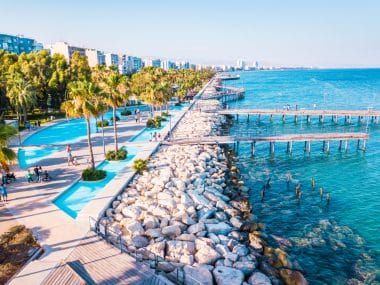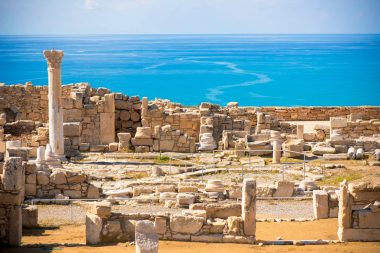Limassol is a port city on the southern coast of Cyprus and the second largest city after the capital Nicosia. Limassol is located in the bay of Akrotiri and is an important tourist and economic center. The city took this position especially after the Turkish invasion in 1974 . As a result of the division, the republic lost the touristically important cities of Famagusta as well as the trading center Kyrenia. Many Cypriots of Greek origin moved to Limassol at that time and settled in the north of the city. As a result, the number of inhabitants doubled and it gained its important position today.
New tourist centre

Limassol has not always been a tourist center. Anyone visiting Limassol today may feel as if they are in two different cities. On the one hand, there is the beach district, which has been redesigned for tourists, with highly polished hotels, clubs and its beach promenade. In addition to the luxury hotels, there are many cafés, restaurants and the extensive promenade with the two modern harbours. It should come as no surprise that most tourists flock here.
Ancient Limassol and its cultures
If you leave the tourist center, you will quickly find yourself in the old town. Some of the buildings here are over 800 years old, historic alleys and typical Mediterranean low-rise buildings invite you to take a walk. Away from the tourist hotspot, Limassol presents itself credibly Cypriot and genuine. The eventful history of the island shapes the city. In addition to the population of Greek origin, many Turks, Lebanese, Armenians and Russians have also settled and bring their own cultural customs with them. These include the Turkish Quarter, one of Limassol’s most popular attractions. Many of the Cypriots of Turkish origin left the city after the partition. However, their quarter with its oriental buildings was not destroyed or disfigured by the Greeks. Instead, people continue to maintain the buildings. Tea rooms and oriental architectural details make up this part of the city.
The beaches of Limassol
Limassol has several beaches. The beach promenade, which has been modernized and spruced up for tourists, begins at the marina in the southwest of Limassol. Akti Olympion Beach is several kilometers long and consists of two parts: A Beach and B Beach. Dogs are allowed at A Beach. Both are clean and family-friendly beaches for city visitors. Apart from that, there are several natural beaches around Limassol. About 8 kilometers from the city and accessible via several hiking trails is Lady’s Mile Beach. Limassol has ideal weather conditions for swimming and water sports almost all year round.
Tip: Also check out our article about the most beautiful holiday resorts in Cyprus!
Cultural buildings

If you are mainly interested in old buildings and architecture, there is a lot to discover in Limassol. The city’s cultural program includes the stronghold of Kolossi, built around 1210 by Frankish knights, located a few kilometers outside the city. The neighbouring church of Agios Eusthathios served as the castle chapel. Visitors can inquire about the history of the city at the Archaeological Museum of Lamissol. The exhibition ranges from the early history of the Neolithic Age to the end of the Eastern Roman Empire. The museum is located north of the zoo. The Medieval Museum is located in the castle, a fortification built in the 13th century on the remains of an older fortress. In 1191, Richard the Lionheart married Berengaria of Navarre here. The wine museum illustrates the 5500-year-old history of viticulture in the area. Other attractions include the Cathedral of Agia Napa and the monastery church of Panagia Karmiotissa. Limassol is also a student city, so it offers a lively pub and cultural scene.
Surroundings of Limassol
Outside the city rises the Troodos, where you can visit pine forests, waterfalls, old bridges and small villages. The surrounding area is also famous for its many vineyards. The wines of this region are popular among connoisseurs and are considered to be of high quality. The hikes in the Troodos Mountains can be combined with wine tastings. However, the fine wines have their price. On a hill by the sea is the archaeological site of Kourion with its ancient buildings: a forum, a bathing establishment, two basilicas and many houses. The finds are presented in the associated museum.




